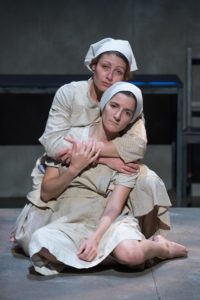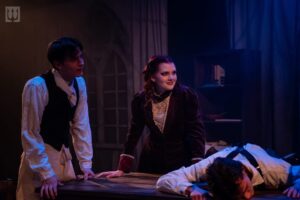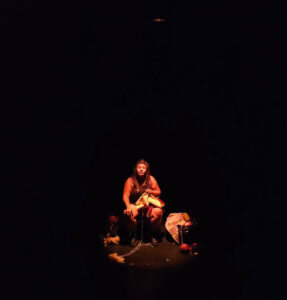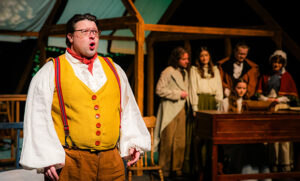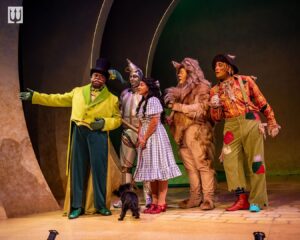amanda leblanc & rachel hastings. photo by bruce dienes
The story of Nova Scotian war hero Mona Parsons seems too unbelievable to be true. In Andria Hill-Lehr and Sarah Jane Blenkhorn’s play The Bitterest Time: The War Story of Mona Parsons, produced by LunaSea and SarAndipity Theatres and running until September 16th, what is so unbelievable in this story is not just that Parsons got her death sentence commuted, it’s not just the idea of a woman from Wolfville, Nova Scotia finding herself playing a major role in the Dutch Resistance working to sabotage the Nazis, it’s not just that she manages to escape from a Nazi prison camp and then gets help from the North Nova Scotia Highlanders, the most remarkable aspect of the story is something that is difficult to convey in the facts and the narrative of Parsons’ experience, but it comes across beautifully in a play. The most remarkable thing about Mona Parsons’ story isn’t what happened to her, it’s the fact that she never lost her unique spirit, and instead, used every facet of herself in order to survive… and it worked.
Amanda LeBlanc brings Mona to beautiful, nuanced life in this piece, and the arc for her to play is gigantic. At the beginning of the play Mona is in Vechta, a Nazi prison camp, and we see scenes from her life before the war in pieces of Mona’s daydreams. The play also progresses forward from her transfer to Vechta to her harrowing escape during the bombing of the prison several weeks later. This means that LeBlanc is seamlessly oscillating between a Mona mustering all her strength to find the humour and opportunities for song, poetry and friendship under harsh and dehumanizing conditions, to a Mona happy at home in Holland with her loving husband, to a Mona refusing to betray others in the face of a Nazi interrogation, to a Mona dancing as a Ziegfeld Folly in New York City before she was married, to a Mona, battered and broken, whose courage, self assurance and even sense of reality is beginning to fray under the stress of these extreme circumstances. LeBlanc shines in each version of Mona and has the ability to bring them all together to create a solid and multifaceted woman of depth, intelligence and incredible strength.
Rachel Hastings plays Wendy (Wendelien van Boetzelaer), a twenty-two year old baroness who has also recently arrived at Vechta due to her political activities at University. She becomes Mona’s friend and the co-conspirator in their escape plans. Carroll Godsman plays Wendelien, the grown up version of ‘Wendy,” who functions as the play’s narrator. As in real life, Wendelien chooses to open up about the war for the first time to co-playwright Andria Hill-Lehr during an interview and we hear Hill-Lehr’s questions in her own recorded voice. There is a beautiful connection between Hastings and Godsman’s portrayals of Wendelien- similar mannerism and ways of speaking that make it very clear that although decades distance them, they are very much the same woman. Wendy and Mona, however, are very different. Where Mona’s skills are often grounded in fanciful whimsy, Wendy’s skills are in practicality and her shrewd judgement. Where Mona is still soft and gentle, despite the hardship she has endured, Wendy is tough and protected beneath a more hardened shell. Hastings gives a lovely portrayal of the moments where Mona inspires Wendy to let her in, just a bit, to a world beyond their trauma so eventually Wendy is able to lead Mona back there too. This is mirrored with Godsman’s formidable performance as the older Wendelien, who similarly allows playwright Hill-Lehr to crack her shell a bit.
Sharleen Kalayil plays most of her drunk-on-power Nazi guard in German. It doesn’t matter that most of the audience doesn’t know what she is saying. We understand. Kalayil also plays the sweet pregnant prisoner, Anda, and the deeply conflicted wife of a German farmer who secretly thinks that the Nazis have ruined her country. These three performances give us a lot to consider in the various roles that women had during World War II, and how they intersect with their lack of power and autonomy in society. Garry Williams plays Billy, Mona’s beloved husband, Clarence, the bemused Haligonian who first meets Mona after she crosses the border into Holland, and various Nazi officers. LeBlanc and Williams create a sweet relationship for Mona and Billy, one that holds elements of Hollywood romance, but also show Mona standing up against Billy’s desire to “protect her” by deciding for her what’s safe. He also captures well the sardonic cold banter of a Nazi interrogation. Clarence roots Mona’s story solidly back home, in Nova Scotia. There is a moment concerning chocolates that is especially poignant.
Blenkhorn and Hill-Lehr have used the memory play structure very effectively giving us a nice balance of flashbacks, but also allowing us to experience the bond growing between Wendelien and Mona, which leads to their incredible escape. There could be a bit more and clearer exposition in the scene with Mona and Billy where they are sheltering the downed British airmen, but that’s the only instance the seems to rely on prior knowledge of Parsons’ story. Director Ryanne Chisholm does a great job at finding ways to create movement for characters who are extremely restricted within their environment, and giving us these beautiful glimpses of joy and light, while still maintaining the tension of their terrifying surroundings.
With the recent rise of Neo-Nazis and strong elements of Fascism creeping into governments in places like the United States, and (to a lesser degree) here in Canada, it’s hard not to see obvious parallels with the world today. Mona speaks of the horror of Jewish mothers being separated from their babies. Kathryn Reeves’ character Nika, a German prostitute, uses language to “other” those who she doesn’t perceive as white. The war leaves devastation and droves of refugees in its wake, reminiscent of the current crises in Syria, Yemen and Myanmar. Mona says in the play that she can’t believe that Nazism is happening in the “modern era,” a sentiment that is continually reverberating throughout the Internet today as people with hearts that work seek to grapple with how the world suddenly seems to have regressed so much and so quickly.
The second most remarkable thing about the story of Mona Parsons is that it has just recently started to be told. This dramatically highlights how skewed our sense of history is toward men (and I would argue white, Protestant, English-speaking, straight, wealthy men benefit the most), and in being so skewed we are finally coming to realize that what has been documented, what has been taught, what has been known, is not the entire story (literally it’s just His Story). It is not the entire truth, and it in no way can be viewed as authoritative, objective, or even necessarily factual. We are beginning to realize how much we don’t know and we are getting a better sense that, in fact, we don’t even know how much we don’t know. This play does lovely justice to Mona Parsons, a woman that we, as Nova Scotians, can finally feel very proud to know.
LunaSea Theatre & SarAndipity Theatre’s production of The Bitterest Time: The War Story of Mona Parsons plays at the Neptune Scotiabank Studio Theatre (1593 Argyle Street, K’jipuktuk (Halifax)- the doors closest to the Pizza Pizza) on September 16th at 2:00pm and 8:00pm. Tickets are available HERE or by calling 902-429-7070.
Follow LunaSea on Social Media: Facebook. Twitter. Instagram (@LunaSeaTheatre).

